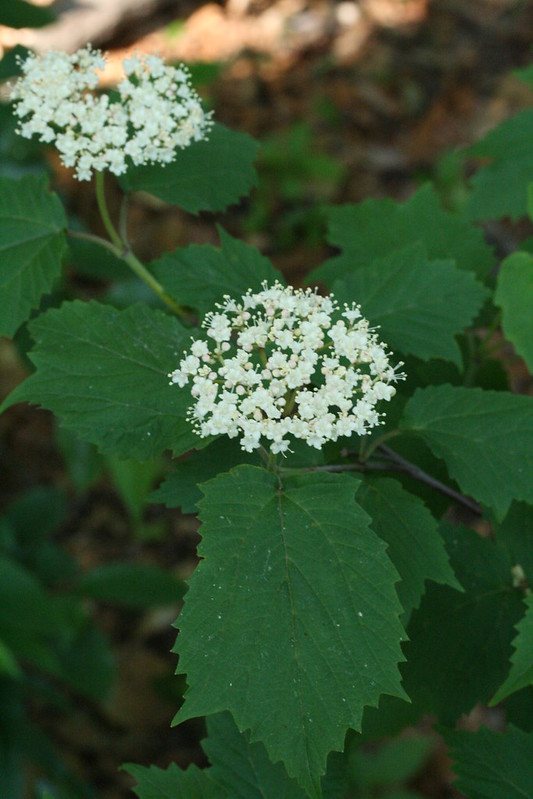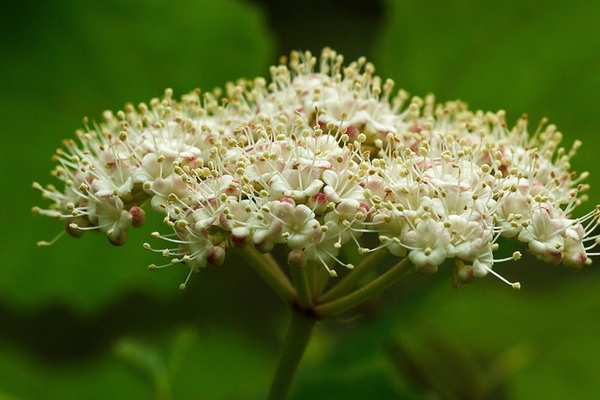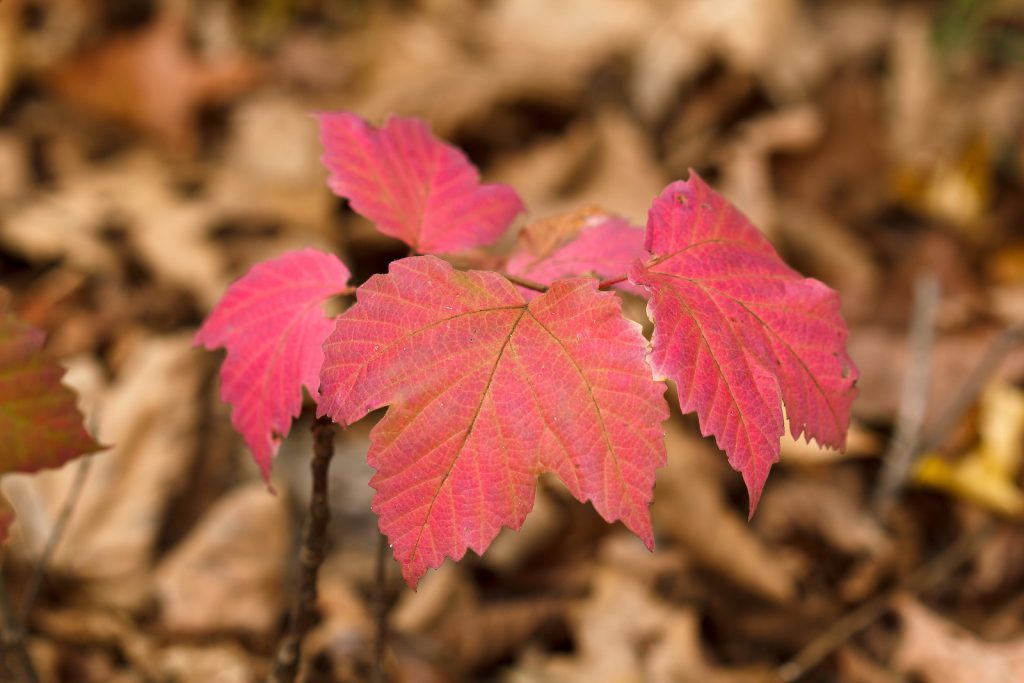Native Plant Profile: Maple-leaved Viburnum (Viburnum acerifolium)
Maple-leaved viburnum (Viburnum acerifolium) is one of our native, short shrubs in the moschatel family (Adoxaceae). It has medium growth that maxes out at heights of 3-6 feet tall and 3-4 feet wide. It often will form a short colony, making it a great plant to use as a low hedge or border. The leaves are deciduous and, as its name suggests, they resemble maple leaves with three main lobes.The leaves are oppositely arranged and grow up to five inches in length.
Maple-leaved viburnum flowers in late April to early May in Maryland. The flowers are creamy white and in small clusters atop the plant. It will flower at 2-3 years of age. Maple-leaved viburnum requires cross pollination to set fruit, and the pollination has to occur between genetically distinct individuals. Therefore, it is best to plant more than one and to make sure the plants you buy are not clones of the same individual. This need for cross pollination is important for all species of viburnum that are native to Maryland. If pollinated, the flowers give way to black fruits in late fall that may persist into the winter. The fall color ranges from a yellow to pink to red and can be quite exceptional if the conditions are right.
Maple-leaved viburnum can grow in part to full shade. It prefers acidic, moist, well-drained soil but can also tolerate dry sites. It is also known to tolerate growing under or near black walnut. Maple-leaved viburnum can be found throughout much of the state, except the lower Eastern Shore. Naturally, these shrubs can be found growing along hillsides.
Maple-leaved viburnum provides a fragrant nectar source for spring bees, including species in the halictid (sweat) bee group and the andrenid (mining) bee group. Numerous other pollinators from flower flies to moths and small butterflies have also been documented visiting. It is also the larval host for species like the spring azure butterfly. The berries are consumed by a variety of birds including ruffed grouse, cedar waxwings, northern cardinals, hermit thrushes, eastern bluebirds, and American robins.
While maple-leaved viburnum is a great addition to many backyard landscapes, I do have a few cautions. First, the introduced viburnum leaf beetle (Pyrrhalta viburni) can be an issue if it gets established. It has been documented in Garrett, Allegany, Baltimore, and Harford counties. Therefore, it is important to be vigilant if you see this beetle on any of your viburnum plants. Second, maple-leaved viburnum can be difficult to find in the nursery trade. Its popularity is growing, so consider asking your local nursery to provide this plant if they do not have it in stock.
References:
Illinois Wildflowers. Maple-leaved viburnum. https://www.illinoiswildflowers.info/woodland/plants/ml_viburnum.htm Accessed April 14 2020.
USDA, NRCS. 2020. The PLANTS Database (https://plants.usda.gov/factsheet/pdf/fs_viac.pdf). National Plant Data Team, Greensboro, NC 27401-4901 USA. Accessed April 14, 2020.
Happy Spring HabiChat fans!
I hope this newsletter finds you and your loved ones happy and healthy. While this certainly is a trying time, we can make the most of quarantine by connecting with our backyard habitats and the residents they support. I have been enjoying the sounds and signs of spring, including watching an amorous mourning dove woo a potential mate. So far, his attempts seem to be successful!
While many local native plant sales have been canceled, vendors have been working to provide plants via online means. Check out the Maryland Native Plant Society website for a list of local vendors. This time is also a great one to tackle some of the invasive plants that may have found their way into your yard. Check out the Plant Invaders of Mid-Atlantic Natural Areas for information on common invaders and how to properly remove them. I, for one, have been tackling quite a bit of periwinkle (Vinca minor) on the weekends.
In this edition of Habichat, I have created articles on our native mining bees which are active early in the spring, the lovely maple-leaved viburnum, backyard birding tips, and how to create backyard habitat while sheltering in place. In addition to HabiChat, I have also included activities to do with children at home on our wildlife education page.
As spring continues, young wildlife are going to venture out from their dens and nests. It’s important to remember that wildlife don’t have the same parenting procedures as we do, and they often ‘free range’ their young. Check out our page on Think Twice Before Rescuing Young Wildlife to learn about normal behaviors of young animals.
Happy Habitats,
Kerry Wixted
Click here to have HabiChat—the quarterly backyard wildlife habitat newsletter from the Wild Acres program—delivered right to your inbox!
In this Issue
Habitat Tips: Creating Backyard Wildlife Habitat While Sheltering in Place
Native Animal Profile: Mining Bees
Native Plant Profile: Maple-leaved Viburnum
Backyard Birding Tips





 1-888-373-7888
1-888-373-7888 233733
233733